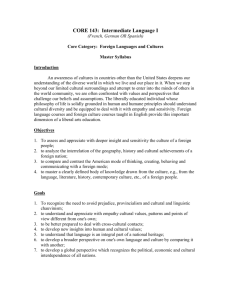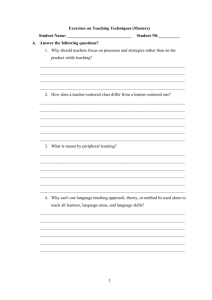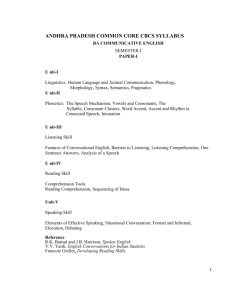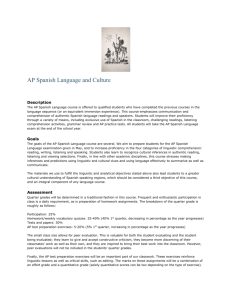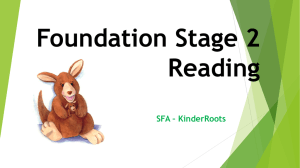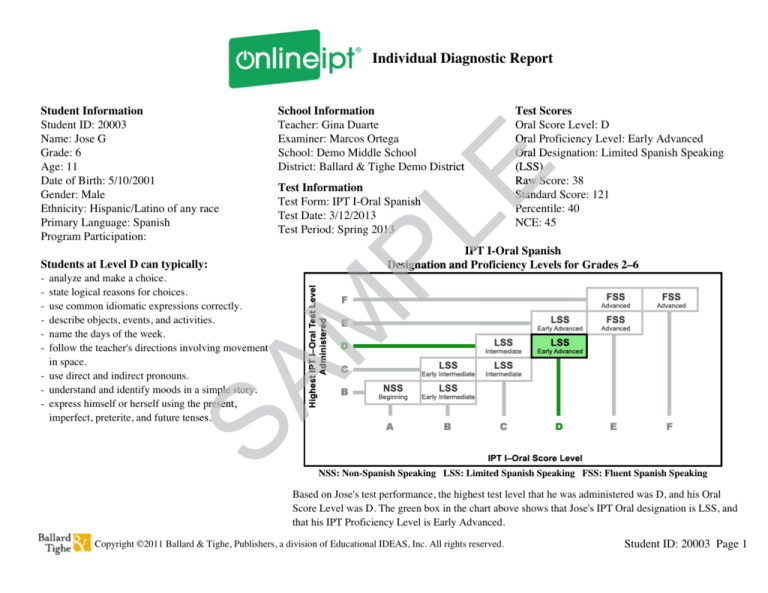
Individual Diagnostic Report
Students at Level D can typically:
analyze and make a choice.
state logical reasons for choices.
use common idiomatic expressions correctly.
describe objects, events, and activities.
name the days of the week.
ent
follow the teacher's directions involving movement
in space.
- use direct and indirect pronouns.
ple story.
- understand and identify moods in a simple
resen
- express himself or herself using the present,
ses.
imperfect, preterite, and future tenses.
E
Test Scores
Oral
O Score Level: D
Or
Oral Proficiency Level: Early Advanced
Or
Oral Designation:
Limited Spanish Speaking
D
(LSS))
aw Sc
Raw
Score: 38
Stan
Standard Score: 121
P
Percentile: 40
NCE: 45
Test Information
h
Test Form: IPT I-Oral Spanish
nish
Test Date: 3/12/2013
013
Test Period: Spring 2013
IPT I-Oral Spanish
Design
Designation and Proficiency Levels for Grades 2–6
SA
M
-
School Information
Teacher: Gina Duarte
Examiner: Marcos Ortega
School: Demo Middle School
District: Ballard & Tighe Demo District
istrict
PL
Student Information
Student ID: 20003
Name: Jose G
Grade: 6
Age: 11
Date of Birth: 5/10/2001
Gender: Male
Ethnicity: Hispanic/Latino of any race
Primary Language: Spanish
Program Participation:
NSS: Non-Spanish Speaking LSS: Limited Spanish Speaking FSS: Fluent Spanish Speaking
Based on Jose's test performance, the highest test level that he was administered was D, and his Oral
Score Level was D. The green box in the chart above shows that Jose's IPT Oral designation is LSS, and
that his IPT Proficiency Level is Early Advanced.
Copyright ©2011 Ballard & Tighe, Publishers, a division of Educational IDEAS, Inc. All rights reserved.
Student ID: 20003 Page 1
Record of Test Answers
The chart below shows in detail how the student performed on the IPT I-Oral Spanish test items on this test occasion. Green print indicates items that
were answered correctly. Bold underlined red print indicates items that were answered incorrectly. Items that were not administered are indicated as
NA.
LEVEL C
LEVEL D
LEVEL E
LEVEL F
7.School Personnel
8.Foods
9.Foods
10.Body Parts
12.Colors
15.People: Family
17.Animals
28.School-related Objects
29.Body Parts
33.Idiomatic Expressions
38.Calendar: Days of the Week
NA
50.NA
2.NA
52.NA
55.N
55.NA
559.NA
60.NA
61.NA
SA
M
PL
E
LEVEL B1
3.Verbs: Present Tense (estar)
11.Plurals
13.Articles: Gender (Definite
Article)
14.Articles: Gender (Indefinite
Article)
16.Prepositions
19.Verbs: Present Progressive
22.Question Formation (Present
Tense)
23.Negative Statements
30.Question Formation (Present
Tense)
*5.Understand Directions
*6.Understand Directions
Involving Locations
20.Identify Details
21.Identify Details
25.Story: Identify Details
tails
26.Story: Identify Details
y Details
27.Story: Identify
ify
1.Give Own Name
2.Give Own Age
4.Give Own Grade
8.Describe Sensations
18.Describe
24.Sentence Repetitio
Repetition
ect Object
40.Pronouns: Direct
mperfect Ten
41.Verbs: Imperfect
Tense
NA
51.NA
3.NA
53.NA
54.N
54.NA
63.NA
64.NA
65.NA
66.NA
67.NA
46.NA
47.NA
48.NA
49.NA
56.NA
57.NA
58.NA
62.NA
68.NA
69.NA
70.NA
71.NA
72.NA
73.NA
74.NA
75.NA
ollow Direct
*39.Follow
Directions
42.Story: Identify C
Characters'
Feelings
43.Story: Ide
Iden
Identify Characters'
Feelings
31.Analyze and Choose
32.Give Rationale
34.Describe What Is Happening
35.Make a Logical Choice
36.Give Rationale
37.Predict Events
44.Predict Development of Story
45.Predict Development of Story
1 Level A is a placement designation only. Students who score Level A answered less than 50% correct on Level B.
* Comprehension items test the accuracy of students' comprehension of item content. Asterisks indicate items that require a nonverbal response. All other Comprehension items require a spoken response.
Copyright ©2011 Ballard & Tighe, Publishers, a division of Educational IDEAS, Inc. All rights reserved.
Student ID: 20003 Page 2
M
Diagnostic Profile of Jose's Test Performance 3/12/2013
ions
*See last page for an explanation
ion of dimensions
Diagnostic Dimensions
SA
Vocabulary
Language
anguage
Functions
Grammar
BICS
king
eaking
Speaking
Comp
Comprehensi
Comprehension
Listeni
Listening
Description of Jose's Diagnostic Profile
The diagnostic information available from Jose's performance on the IPT
I-Oral Spanish indicates that he has good control of vocabulary, grammar,
comprehension, listening, and basic interpersonal communication skills
(BICS) or social language. In these areas, he is on his way to reaching the
next proficiency level. He is weakest in language functions. His control of
speaking also shows some weaknesses.
The diagnostic dimensions of BICS, Speaking, and
nd Listening
Listen
are each made up of two
ocab
other diagnostic dimensions. BICS is made up of vocabulary
and grammar, speaking is
made up of grammar and language functions, and listening is made up of language
functions and comprehension. The combination is based on a content analysis of the test
items.
Copyright ©2011 Ballard & Tighe, Publishers, a division of Educational IDEAS, Inc. All rights reserved.
Student ID: 20003 Page 3
SA
M
PL
E
Explanation of the Dimensions in the Diagnostic Profile
Vocabulary
Vocabulary items test students' knowledge of single words (nouns or adjectives) that range from basic and concrete at the
early proficiency levels to more abstract at the higher levels.
Grammar
Grammar items test students' knowledge of the correct use of grammatical forms at the word, phrase, and sentence levels.
They include both morphology and syntax.
Comprehension Comprehension items assess the students' ability to comprehend directions, descriptions, comparisons, and stories. Story
awin low-level inferences.
comprehension includes understanding the main idea and details as well as drawing
awing
Language
Language functions are things that students "do" with language, such as des
describin
describing, narrating, or explaining. Language
Functions
functions include academic language as well as tasks that belong to general Spani
Spanish
Spanish, ranging from self-identification to
describing events and expressing and justifying opinions.
me items on the IP
Listening
Listening is the skill of hearing auditory input and comprehending
ng it. Some
IPT concentrate solely on listening
by having the students point to or act out the responses to the examiner's prompt, while oothers test a combination of listening
ds both on the correct comprehension of the prompt and the
and speaking, so that the acceptability of the answer depends
pends
correct oral production of the response by speaking. On the diagnostic profi
profile
profile, the items that make up the Listening
nd language functions, be
dimension consist of items that test comprehension and
bec
because correct responses to these items reflect
students' ability to understand spoken language.
Speaking
Speaking is the skill of expressing something orally. On the IPT
IPT-Oral, sp
speaking items vary in complexity from single-word
xplanations. O
responses to multi-sentence descriptions or explanations.
On the diag
diagnostic profile, the items that make up the Speaking
mmar and language func
dimension consist of items that test grammar
ammar
functions, because correct responses to these items reflect
d comprehensibly.
students' ability to speak accurately and
al Communication Sk
BICS
BICS stands for Basic Interpersonal
onal
Skil
Skills. It stands in contrast to Cognitive Academic Language
Proficiency (CALP). The distinction
tion wass made by Jim C
Cum
Cummins (1979, 1981) to point out the challenges of second language
learners in catching up to their
irr native speaking peers in school language. BICS refers to everyday conversational fluency, or
anguage." Cummins w
what is often termed "social
al language."
wa
wanted to raise practitioners' awareness that high proficiency in BICS can
ge learners. It does not mean that these students will learn CALP skills as quickly or in the
be deceptive in second language
ative speaking peers. On tthe diagnostic profile, the items that make up the BICS dimension consist of
same way as their native
ocabulary and gram
items that test vocabulary
grammar, bbecause correct responses to these items reflect students' ability to talk about
everyday topics.
s.
Copyright ©2011 Ballard & Tighe, Publishers, a division of Educational IDEAS, Inc. All rights reserved.
Student ID: 20003 Page 4

